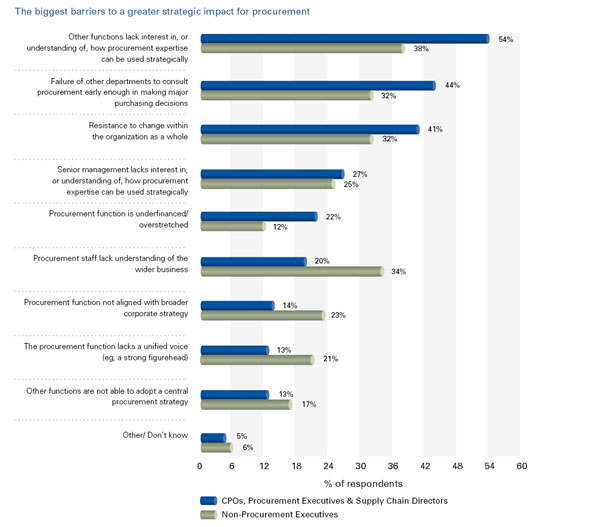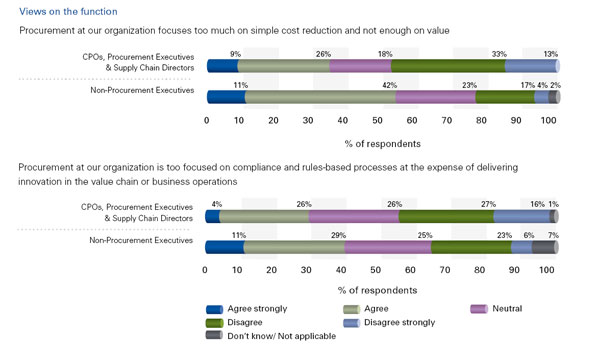But, barriers remain to procurement moving up on the corporate ladder. As shown in the chart below, there are disconnects in perceptions between procurement execs and other company managers. Procurement-related staff thinks the biggest barrier to procurement becoming more strategic is the lack of understanding or interest by other functions in that evolution; conversely, executives outside of procurement think the biggest barrier is that procurement managers don’t well understand the business.
Executives from both areas, however, largely believe procurement skills should be better utilized earlier in the process when making sourcing and related decisions.

Source: KPMG International
Do procurement managers focus too much on “cost reductions” versus overall value, and the minutia of compliance with various procurement policies versus innovation?
53% of non-procurement executives either agree or strongly agree with statement that the procurement function is too focused on cost and not enough on value, and another 40% say the same about the focus on policies versus innovation. An additional sizable percentage was neutral on both questions, meaning a small percentage of respondents actually disagreed with those statements.
Not surprisingly, the answers from procurement-related executives were more positive, but this again highlights a strong perception gap.

Source: KPMG International
Bell Canada Drives Alignment – and Results
Jeff Gallant, Vice President Procurement at Bell Canada, offers some thoughts in the report about how the procurement function can add more value and move up the chain.
“Often companies do a great job of negotiating cost savings with the supply base but cannot materialize it in the organization,” Gallant says. “To do so, it has to be an inclusive and collaborative process with other business units.”
Gallant says a re-energized procurement function at Bell Canada saved the company hundreds of millions of dollars in 2006 and 2007. How? In part, by putting real wood behind the procurement arrow.
For example, once procurement is ready to implement savings, “We develop a detailed, analytical business case at the business unit level, to determine each units' cost savings,” Gallant says.
It presents the on-going results of the cost reduction efforts monthly to the business unit controllers, who all participate in a “Benefits Realization Council.”
When a controller signs off on the savings, as happens for about 90 percent of the reductions which procurement identifies, “the budgets get pulled out, and the business unit is motivated to use the strategy,” Gallant adds.
The Bell Canada procurement team assists further by helping with change management, and analyzing spend at the unit level.
The report offers a wide variety of other insights and data useful to both procurement managers and other functions.
“The research shows that organizations understand that they cannot operate without reference to the markets in to which they sell: this is also true of the Markets from which they purchase their inputs,” the report notes. “Procurement is the part of the business most exposed to the latter and therefore a potentially important source of information not apparent to other executives on opportunities, innovation, competitor behavior, best practice, and certain risk issues.”
Do you agree with the researcher data on barriers to raising the profile of the procurement function? What do you think needs to change inside or outside most procurement organizations? Do you like Bell Canada’s approach of a “Benefits Realization Council?” Let us know your thoughts at the Feedback button below. |